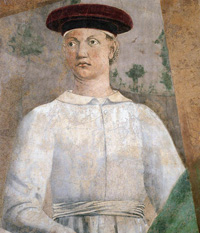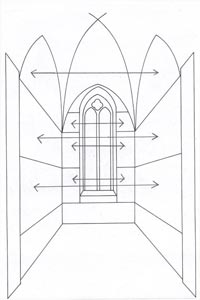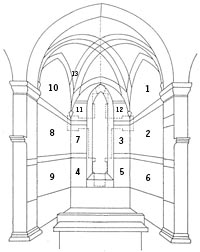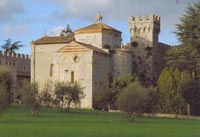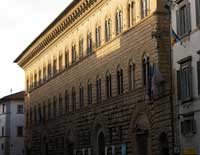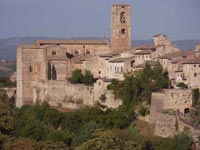| |
|
Churches
|
|
|
The Gothic Cathedral of Saint Donatus (13th-early 16th centuries). The façade remained unfinished, and was added in the 20th century. The interior has a nave and aisles divided by massive pilasters. The left aisle has a fresco by Piero della Francesca portraying the Mary Magdalene. Noteworthy are also the medieval stained glass, the Tarlati Chapel (1334) and the Gothic tomb of Pope Gregory X.
|
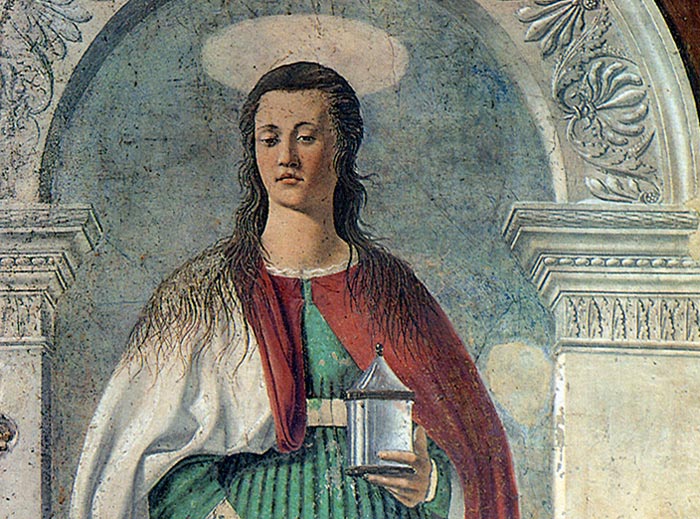 |
Piero della Francesca,, Mary Magdalene, fresco, 190 x 105 cm Arezzo, Duomo, 1460
|
The cathedral of Arezzo, dedicated to San Donato, is an imposing Gothic construction that was begun at the end of the thirteenth century and work continued, with various interruptions, up to the beginning of the sixteenth century, when the stairway at the front was added. It dominates the top of the hill with its mass and is higher than any other viewpoint of the city. The façade, which had remained unfinished since the beginning of the fifteenth century, was completed at the beginning of the nineteenth century to the design by Dame Viviani, with statues and bas-reliefs by Giuseppe Cassioli and Enrico Quanrini. The fourteenth century Florentine-style portal on the right is flanked by two truncated columns of porphyry from an existing building, perhaps a Roman temple, and it also has a lunette with a fourteenth century opus signinum sculptural group representing a Madonna and Child with saints and angels by Niccolb di Luca Spinelli.
In the mid nineteenth century the bell tower was built next to the polygonal apse, but the spire was only added in the twentieth century. The interior is divided into three naves by high, multiple column pilasters that, together with the pointed arches, give the building a strong upward thrust. The two marble pulpits of the central nave were made by artists from the Marche region, during the sixteenth century. The Chapel of Ciuccio Tarlati, of 1334, opens at the end of the right nave, where a handsome marble urn with symbolic figures from the fourth century AD is conserved. The chapel also has a fresco by Maestro del Vescovado (Master of the bishop's palace), a painter active about the middle of the fourteenth century, which depicts the Crucifix, Madonna, three saints and Ciuccio di vanni Tarlati di Pietramala. The Ark of San Donato is located in the presbytery and constitutes the upper part of the main altar, which has the form of a rich urn of marble, based on twelve small pilasters, and crowned with Gothic spires and pinnacles: a complex construction that involved artists from Siena, Florence and Arezzo during the fourteenth century. The lower section of the front side was primarily the work of Agostino di Giovanni and Agnolo di Ventura, the upper section was the work of Giovanni di Francesco e Berro di Francesco. In the left nave, next to the door of the sacristy, there is a magnificent fresco of Mary Magdalene by Piero della Francesca. The funeral monument to Guido Tarlati, bishop and noble of Arezzo who died in 1327, stands to the left of the fresco. It was completed by Agostino di Giovanni and Agnolo di Ventura in 1330. Many of the beautiful stained glass windows of the cathedral were made by Guglielmo de Marcillat (sixteenth century). Finally, the grandiose Renaissance organ, on great marble brackets, was designed by Vasari in his youth. The Chapel of Comfort, a construction with three naves and an apse, was built at the end of the eighteenth century and conserves some Della Robbia terracottas.
Mary Magdalene
The fresco in the cathedral of Arezzo which depicts Mary Magdalene is almost hidden by the monumental fourteenth century cenotaph of bishop Tarlati. Painted entirely by Piero himself, it was considered a minor work of the great artist until the nineteenth century, despite the high quality of the fresco, even easier to appreciate today after being restored. The Saint appears in all her beauty and naturalness, accentuated by her hair spread on her shoulders, which reveals Piero's great attention to the Flemish masters. The unbound hair may be an allusion to the previous licentiousness of a saint who redeemed herself from the life of a courtesan. The majestic figure fills the arch of a classic portico of marble and shines with the beauty of the lively colors of the garments, the green dress, the red and white mantle. Unfortunately the color of the background is completely lost, which must have been a very intense and luminous azure, and the gold of the halo is gone too. Mary Magdalene holds a corner of her mantle with her right hand and in the other seems to offer the jar containing the perfumed ointments she applied to Christ's feet, drying them afterwards with her hair. Piero used a chromatic play of shadows and transparencies to create the volume of the figure, in which the exploration of the illumination helps to delicately describe the physical presence of the woman: her perfect skin, her rosy cheeks and beautiful neck are distinguished by the light from the left that illuminates her face, which is both sweet and reflective. The particular focus on the illumination and the naturalistic presence, which reveal Flemish influence, lead scholars to date this fresco to after the Roman interval, prior to 1465 but after the frescos in San Francesco were finished.[2]
Art in Tuscany | Arezzo Cathedral | Cattedrale dei Santi Pietro e Donato
|
|
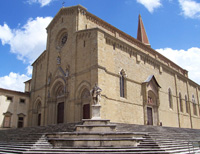 Arezzo, Duomo Arezzo, Duomo
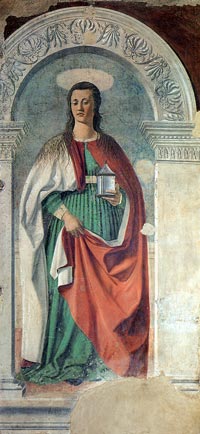 Santa Maria Maddalena, Dome, Arezzo Santa Maria Maddalena, Dome, Arezzo
|
The church of San Francesco
|
The church of San Francesco was started in the middle of the thirteenth century and was designed as a single open space according to the practices of the new mendicant, preaching religious orders, including the Franciscans. The building was completed in the 14th century and the bell tower was added in the 16th century. The church contains one of the most important masterpieces of renaissance painting; The Bacci Chapel with its fresco cycle of the legend of the True Cross painted by Piero della Francesca between 1452 and 1466. Under the church is another Basilica with a nave and two aisles (Basilica inferiore), today used for art exhibitions.
The statue of Vittorio Fossombroni is in the Piazza San Francesco in front of the church. Vittorio's heirs had the statue made and given as a giftto Arezzo in 1864. Vittorio was a citizen of Arezzo as well as a scientist and politician. He was an engineer for the Grand Duke of Tuscany. His is remembered for his draining of the marshes around Arezzo that increased the beauty and health of the town.
San Francesco is the second church built by the Franciscans in Arezzo, an earlier church being located outside the city walls and destroyed during the Occupation. The building work on San Francesco was begun around 1290. The decoration of its façade was never realised.
The interior presents as a large church of simple unadorned design with a wide single nave, flanked on the left side by some chapels and, on the right side, by some niches. The tall groin-vaulted chancel is of square plan.
At the chancel entrance is suspended a very large painted rood crucifix by one Master of San Francesco, a contemporary of Cimabue. It also contains a Maesta or "Madonna in Majesty" by Guido da Siena.
The walls and particularly the niches on the right have some fresco decoration, which dates in part to the 14th century.
The Cappella Maggiore, (Major Chapel or chancel) houses one of the masterworks of Italian Early Renaissance, a fresco cycle by Piero della Francesca depicting the Legend of the True Cross.
|
|
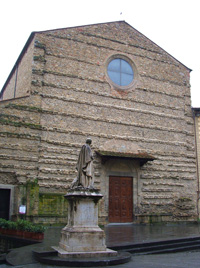
The church of San Francesco and the statue of Vittorio Fossombroni
Vittorio Fossombroni (15 September 1754 – 13 April 1844) was an Italian statesman, mathematician, economist and engineer. In 1794 he was entrusted by the grand duke with the direction of the works for the drainage of the marshy Valdichiana, one of the four valleys around Arezzo, on which subject he had published a treatise in 1789.
|
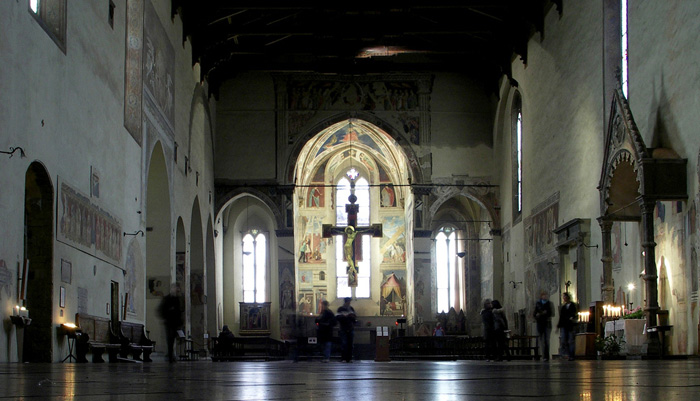 |
Arezzo, the church of San Franceso, interior |
Piero arrived in Arezzo in 1452, and interrupted his stay during the years 1458-59, when he went to Rome at the invitation of pope Pius II Piccolomini. For some scholars, the latter dates mark the completion of the frescos in Arezzo, according to others this was just one of Piero's many interruptions, and they believe that he continued to work on the frescos after his return. After the success and admiration that Piero inspired with his masterwork about the Legend of the True Cross, he received many commissions, including the Mary Magdalene for the cathedral of Arezzo. Today we don't know if it was a simple devotional image as it appears to us or if it was part of a larger composition that has since disappeared. Another work by Piero is well-documented, although it has since disappeared: the standard with the Annunciation, commissioned in 1466 by the religious company dedicated to the Virgin of the Annunciation. Arezzo was full of Piero's imitators, mostly mediocre, with the exception of Lorentino d'Andrea, his assistant for the cycle in San Francesco.[2]
|
Piero della Francesca | The Legend of the True Cross | The Frescoes of San Francesco in Arrezzo
|
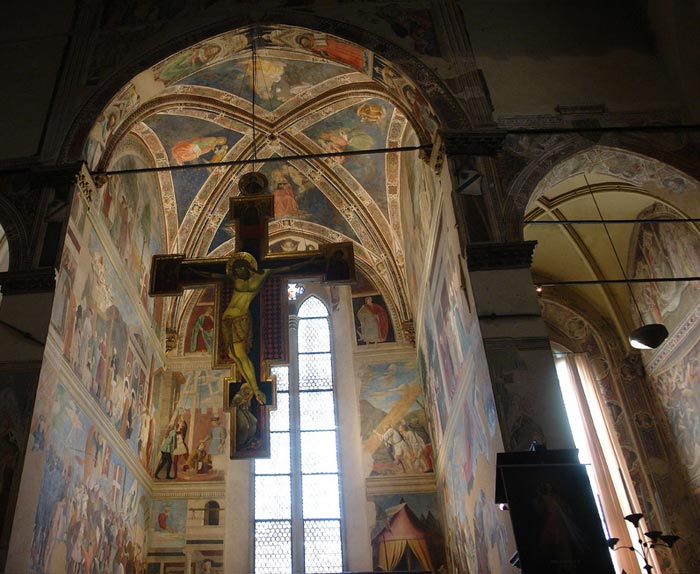 |
La Cappella Maggiore di San Francesco, Arezzo
|
The theme of the cycle of the True Cross had been used
by Agnolo Gaddi, a few decades before, in the Franciscan
church of Santa Croce in Florence. One of its sources
was a hagiographic compilation from the 13th century
called the The Golden Legend, by Jacopo da Varagine.
The frescos are placed on three levels on the back and
side walls. On the back wall two key scenes are shown.
On the left is The Annunciation, which was the first act
in the human events of the life of Christ. On the right is
Constantine's Dream, from which began the historical events to rediscover the True Cross, which then became
the victory Standard of the Christian monarchs. The other
painted scenes represent episodes taken from the Old
Testament and the events leading to the Finding of the
True Cross by the Empress Helena. Piero della Francesca
did not follow the chronological order of the events when
he was designing the cycle but, instead he developed a
symmetry between the various scenes painted; on the
top level open air scenes were shown, in the middle
court scenes and on the bottom level were battle scenes.
The main episodes depicted are:
1 Death of Adam; Seth meeting the Archangel Michael
Adam (on the right), on his death-bed, sends his son, Seth to the
Archangel Michael, keeper of the Gates of Paradise, to get some oil of
mercy; the Archangel (seen in the background) refuses the oil but gives
him a seedling from the tree of Original Sin to be placed in Adams mouth when he is buried (on the left); from this shoot and from Adam's body, which had been the cause of man's downfall, a healthy tree would grow
(centre) the wood of which would be used for Christ's Cross and thus for
the resurrection of man.
2 The Adoration of the Holy Wood; the Queen of Sheba kneels in front of the wood from which the cross will be made and meets King Solomon
Centuries later, Solomon, King of Israel, has the tree cut down but
the wood could not be worked in any way so it was thrown across the
river Silo to make a little bridge. The Queen of Sheba, when visiting the king, fell to her knees (centre) in front of the wood, having had a premonition of how it would be used: the crucifixion of the Messiah. During
her meeting with King Solomon (on the right) the Queen revealed her
premonition.
3 The burial of the Sacred Wood
On King Solomon's orders, the wood, which would be the cause of the
scattering of the Jews, was removed and thrown into the depths of the
earth. (note the similarity in iconography to that of the Road to Calvary).
4 The Annunciation to Mary
5 The Vision of Constantine
On the eve of his battle against Maxentius in 312 AD, Constantine
the Great was told in a dream that he would have victory in the name of
the Cross.
6 The Victory of Constantine (Constantine's victory over Maxentius at the battle of Milvian Bridge)
7 The Torture of Judas the Jew
All trace of Christ's Cross had, in the meantime, been lost, so Constan-
tine's mother, Saint Helena, went to Jerusalem to find it and to build the
Basilica of the Holy Cross. There she met a Jew who knew where the Cross
was buried but did not want to tell her. However, after having been put
into the bottom of a dry well for six days and nights the man agreed to
reveal where the Cross was.
8 The Discovery and Proof of the True Cross
The three crosses were then dug up in Jerusalem (seen in the back-
ground on the left; in actual fact Arezzo with the Cathedral of San Donato
and San Pietro clearly visible). To distinguish the cross of Christ from those
of the two thieves, they were taken in turn to the body of a dead youth
who came backto life (on the right) when touched by the True Cross. Saint
Helena knelt in front ofThe True Cross in adoration (as had the Queen of Sheba in the corresponding painting on the right wall).
9 The Battle of Heraclius and Chosroes
In 615 AD the Persian king Chosroes had profaned the Cross by placing it next to his own throne (on right). The Eastern Emperor Heraclius
faced him in battle (on left) and won, but when Chosroes refused to con-
vert to Christianity he was condemned to decapitation (the detail shown
again on the right).
10 The Exaltation of the Cross
Heraclius carried the Cross back to Jerusalem: in great humility, with
bare feet and just a simple robe, he offered it in adoration to a group of
nobles of the Sacred City.
11 The Prophet Isaiah
12 The Prophet Jeremiah
13 An angel
|
|
|
| |
| |
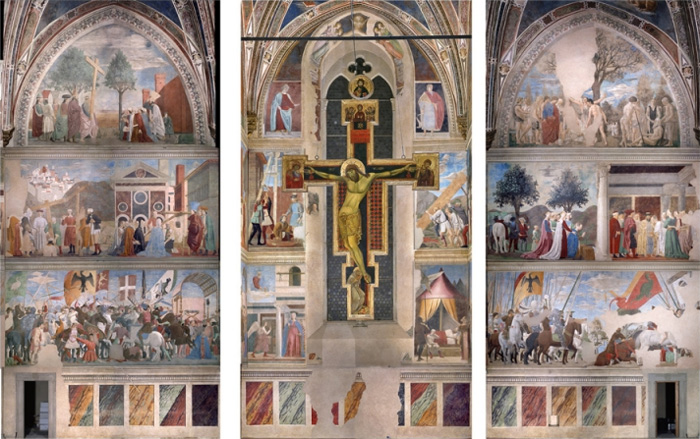 |
Le tre pareti della Cappella Bacci (foto: A. Benci)
|
Piero della Francesca | The Legend of the True Cross | The Frescoes of San Francesco in Arrezzo
Museo Basilica di San Francesco
Via di San Francesco - 52100 Arezzo
Tel. 0575 352727 - Fax 0575 302001
info@pierodellafrancesca-ticketoffice.it
|
Luca Signorelli was born in Cortona and, according to Vasari, learned to paint from Piero della Francesca. Although no works from his earliest years have survived, those painted after 1470 are similar in style to his teacher. The influence of Verrocchio which can also be seen in these early works would seem to indicate that he had some sort of contact with Verrocchio’s workshop in Florence.
He must then have worked with Perugino in Rome, helping with the frescoes in the Sistine Chapel, particularly the Testament of Moses. After remaining in Rome for quite an extensive period of time he returned home and was given some interesting commissions such as the Annunciation in Volterra.
This was followed by the fresco cycle Scenes from the Life of St. Benedict in the monastery of San Oliveto Maggiore (Siena), and between 1499 and 1501 the San Brizio Chapel, his most important work.
The painter did not always reside in Orvieto and he created other works, such as the San Sebastian, in Città di Castello, and the Lamentation at the foot of the Cross, in Castiglione Fiorentino.
In 1508 he was summoned to Rome to paint the large rooms in the Vatican but of this work nothing remains. He died in Cortona in 1523.
|
|
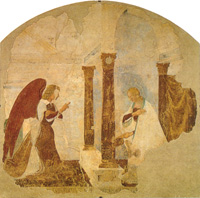
Luca Signorelli, Annunciation, Chiesa di San Francesco, Arezzo
|
Santa Maria della Pieve
|
Romanesque church of Santa Maria della Pieve. Its most striking feature is the massive, square-planned bell tower with double orders of mullioned windows. The church was built in the 12th century over a pre-existing Palaeo-Christian edifice, and renovated a century later with the addition of the characteristic façade made of loggias with small arches surmounted by all different-styled columns. Also from the same century is the lunette with the Virgin between Two Angels and the sculptures of the months (1216) over the main portal. The interior has a nave and two aisles, with a transept also added in the 13th century. In the following century chapels, niches and frescoes were added, including the polyptych of Virgin with Child and Saints by Pietro Lorenzetti (1320). In the crypt is a relic bust of St. Donatus (1346). From the same epoch is the hexagonal baptismal font, with panels of the Histories of St. John the Baptist, by Giovanni d'Agostino. The Pieve was again renovated by Giorgio Vasari in 1560.
|
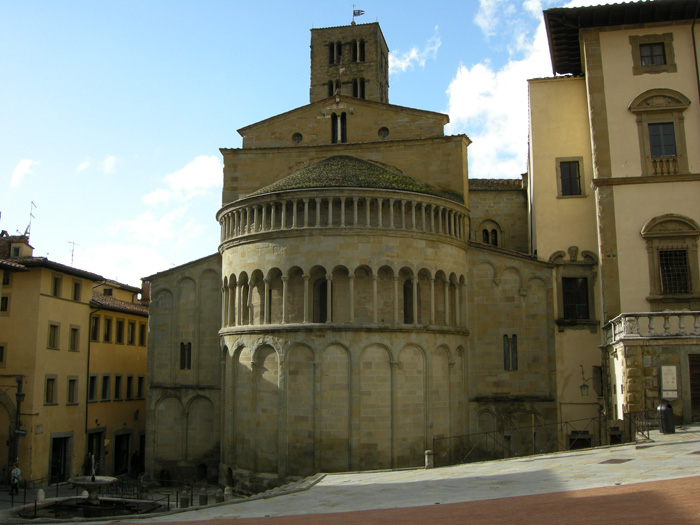 |
Santa Maria della Pieve, view of the apse
|
The church is documented since as early as 1008, and, during the communal period of Arezzo, it was the stronghold of the city's struggle against its bishops. After the latter built the nearby Cathedral and palace, the church, which had been already rebuilt in the 12th century, was further renovated with the façade and the apse, and the interior was remade in Gothic style (13th century).
The church's most striking feature is its façade, with a a five-arches lower floor surmounted by three loggias, with the number of columns increasing with the elevation. The columns, and its capitals, are each different from the other (one is a statue). The original façade had no particular features, the current decoration having been added in the 12th century.
The central portal has a barrel vault entrance, and a lunette with a bes-relief of the Praying Madonna with Angels. Under her is a frieze with small angels, and the signature by one Marchionne. In the vault are depictions of the Months of the school of Benedetto Antelami. The two side portals, of smaller proportions, have also decorated lunettes: they depict "Christ Baptized by John" on the right and, at the left, a vegetable motif.
The 13th century apse has also two rows of loggia which recall the façade's structure, repeating the use of different style capitals. The sides have mullioned windows.
The tall interior has a nave and two aisles, divided by longitudinal ogival arches whose columns have Corinthian capitals. The counter-façade has nine windows on three rows. At the high altar is the Tarlati polyptych, representing the Madonna and Saints, by Pietro Lorenzetti (1320) This polyptych has fortunately been preserved in its entirety is still in its original setting. It is a fine example of a fourteenth-century polyptych which centres around the image of the Virgin and Child. The size of the figures shown in the various tiers gradually gets smaller. The influence of Duccio is obvious.
Traces of frescoes with St. Dominic and St. Francis (attributed to Andrea di Nerlo, mid-14th century) can be seen inside the church. The crypt houses a reliquiary bust of St. Donatus, executed in 1346.
The bell tower has a sturdy appearance with five rows of mullioned windows. Internally, the base houses the baptistery. The baptismal font dates to the 14th century, and has panels with Stories of St. John the Baptist by Giovanni d'Agostino (1332–1333).
The Tarlati polyptych is a Renaissance polyptych painted by Pietro Lorenzetti, with tempera and gold on panel, in 1320. It depicts the Madonna and Child with Donatus of Arezzo, John the Evangelist, John the Baptist and Saint Matthew.
The term Tarlati refers to Guido Tarlati, who was the bishop of Arezzo and died in 1327.
Art in Tuscany | Pietro Lorenzetti | The Tarlati polyptych (1320)
|
|
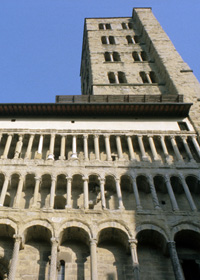
Santa Maria della Pieve, the bell tower and façade. The bell tower, finished in 1330, is in Romanesque style.
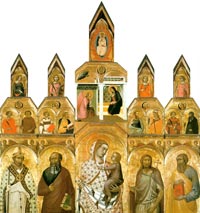
The Tarlati polyptych by Pietro Lorenzetti, 1320, at Santa Maria della Pieve, includes a depiction of Donatus of Arezzo (far left)
|
Piazza Grande
|
|
|
The Piazza Grande sits near the top of the hill in the center of the old town, and just below the Norman Cathedral and the Medici Fortress. The plaza was first laid out around 1200, and it is remarkable for the way it resolves the steep slope of the site and the buildings around it. The facades of the 3 buildings on the west side of the space are fronted by steep stairways and podiums along their bases that make up the slope, while the pavement of the plaza drops off sharply to the south in front of them. This view is looking west through the well towards the Palazzo dei Tribunale and the Pallazo della Fraternita de Laici. On the left is the arcaded apse of Santa Maria della Pieve, and on the right the collonade of the Palazzo delle Logge closes off the north side of the space. The east and south sides of the square are lined with private town houses, some with defensive towers and wooden balconies and galleries.
|
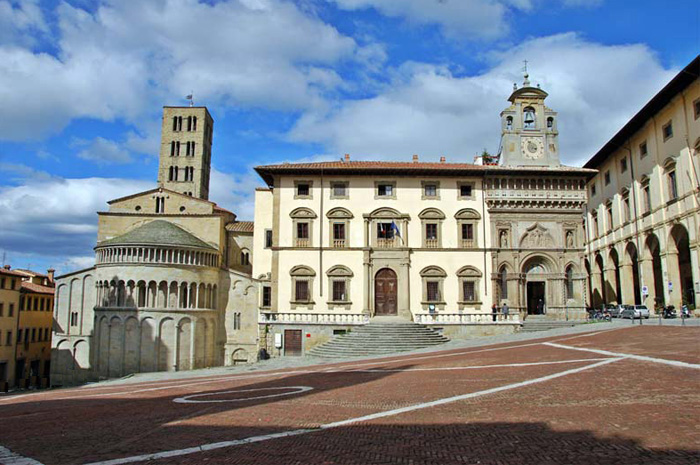 |
Piazza Grande, with the apse of Santa Maria della Pieve, the old Tribunal Palace and the Lay Fraternity
|
The Piazza Grande is the most noteworthy medieval square in the city, opening behind the 13th century Romanesque apse of Santa Maria della Pieve. Once the main marketplace of the city, it is currently the site of the Giostra del Saracino ("Joust of the Saracen"). It has a sloping pavement in red brick with limestone geometrical lines. Aside from the apse of the church, other landmarks of the square include:
The Palace of the Lay Fraternity (Fraternita dei Laici): 14th-15th century palazzo, with a Gothic ground floor and a quattrocento second floor by Bernardo Rossellino.
The Vasari Loggia along the north side, a flat Mannerist façade designed by Giorgio Vasari.
Episcopal Palace, seat of the bishops, rebuilt in the mid-13th century. The interior has frescoes by Salvi Castellucci, Teofilo Torri, and Pietro Benvenuti. In front of the Palace is the Monument to Grand Duke Ferdinando I de' Medici (1595), by Pietro Francavilla, following a design of Giambologna.
Palazzo Cofani-Brizzolari, with the Torre Faggiolana.
Remains of the Communal Palace and the Palazzo del Popolo can also be seen.
|
Basilica of San Domenico (founded in 1275 and completed in the early 14th century). The interior has a single nave with a Crucifix by Cimabue, a masterwork of 13th century Italian art. Other artworks include a Sts. Philip and James the Younger and St. Catherine by Spinello Aretino and other 14th century painting and sculpture decorations.
|
Among the major works attributed to Cimabue is the large cross in the church of Saint Domenico in Arezzo. It is believed that the painting dates to around 1270. An innovative element is that is depicts Christ in the dramatic moment of his death, underlining the commonality with human suffering. This painting, while innovative in many respects, is not yet the full expression of Cimabue's later style.
Two painted wood crucifixes demonstrate the evolution of Cimabue's style. The Santa Croce Crucifix in Firenze is probably one of the most recognized of Florence's treasures. Badly damaged by the Arno flood of 1966, it now hangs in the refectory of the Museo dell'Opera di Santa Croce.
In the earlier work, in San Domenico, Arezzo, the artist retained traditional Italo-Byzantine conventions, especially in the linear definition of muscles, treatment of the hair, gold striations in the opaque loincloth, and two bust-length portraits in the terminals. The later work, formerly in Santa Croce, Florence, which probably dates from about the same time as the murals in Assisi, showed a new softness of modeling and abandonment of some Byzantine conventions, like gold striations. The torso of Christ was modeled with broad, widely varied tones which tended to suppress the tortoiseshell appearance seen in the Arezzo crucifix. In the Florence crucifix Cimabue was moving further along the path toward greater naturalism.
Art in Tuscany | Cimabue, the Crucifix of San Domenico, Arezzo
Art in Tuscany | Cimabue, the Crucifix of Santa Croce at Florence
|
|
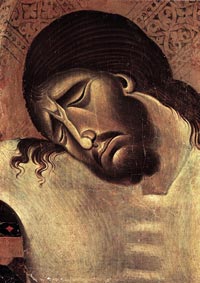 Cimabue, Crucifix (detail), 1268-71, tempera on wood, 336 x 267 cm, San Domenico, Arezzo
Cimabue, Crucifix (detail), 1268-71, tempera on wood, 336 x 267 cm, San Domenico, Arezzo
|
Other churches
|
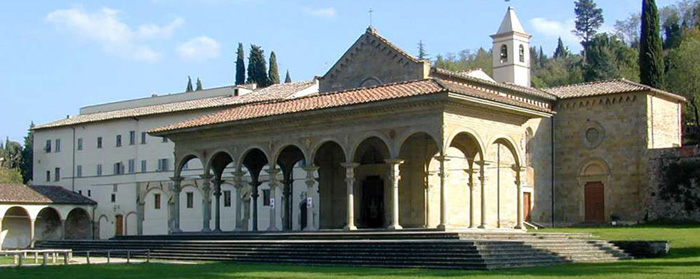 |
Sanctuary ofi Santa Maria delle Grazie
|
Church of San Michele, with a modern façade. Traces of the original Romanesque edifice and the Gothic restoration can be seen in the interior.
Santa Maria in Gradi is a medieval church from the 11th or the 12th century, but was rebuilt in the late 16th century by Bartolomeo Ammannati. The interior has a single nave with stone altars (17th century) and a Madonna of Misericordia, terracotta by Andrea della Robbia.
Church of St. Augustine, founded in 1257, modified in the late 15th and the late 18h centuries. The façade and the interior decoration are largely from Baroque times. The square plan bell tower is from the 15th century.
Badia di SS. Flora e Lucilla (12th century). Built by Benedictine monks in the 12th century, it was totally restored in the 16th century under the direction of Giorgio Vasari. The octagonal bell tower is from 1650. The interior, in Mannerist style, has an illusionistic canvas depicting a false dome by Andrea Pozzo (1702). There are also a St. Lawrence fresco by Bartolomeo della Gatta (1476) and a Crucifix by Segna di Buonaventura (1319).
San Lorenzo, one of the most ancient of the city, having been built before the year 1000, most likely in Palaeo-Christian times. Rebuilt in the 13th century and restored in 1538, it was totally rebuilt in 1705. The apse exterior is in Romanesque style.
Santa Maria delle Grazie, a late Gothic sanctuary with a Renaissance portal by Benedetto da Maiano (1490). It has also a marble high altar by Andrea della Robbia including a pre-existing fresco by Parri di Spinello (1428–1431). The sanctuary was built over a font dedicated to Apollo, which was destroyed by San Bernardino of Siena in 1428, building an oratory in its place. The church was erected in 1435–1444 and has a chapel entitled to St. Bernardino.
Church of Santissima Trinità. Built in 1348, it was totalle renovated in 1723–1748 in Baroque style. It houses a 14th century Crucifix, a banner painted by Giorgio Vasari in 1572, a painting of Noli me tangere by Alessandro Allori (1584) and other artworks.
Santa Maria Maddalena, built in 1561 over a pre-14th century structure. It houses a Madonna with Child (Madonna of the Rose) by Spinello Aretino, visible in the high altar (c. 1525) designed by Guillaume de Marcillat. It is now private property.
Pieve di San Paolo, in San Paolo, erected as Palaeo-Christian baptismal church, rebuilt in the 8th-9th centuries and then rebuilt in Romanesque style in the 13th century. The bell tower is from the 14th-15th centuries. The entire church was again renovated after the 1796 earthquake. It has kept 15th-century frescoes by Lorentino d'Andrea and a cyborium. The transept entrance has granite columns with marble capitals from the 5th century AD.
Pieve di Sant'Eugenia al Bagnoro, in Bagnoro. Documented from 1012, it was one of the most important pievi of the diocese during the Middle Ages. The presbytery area is from the 12th century, while the rest is from the 11th century. The bell tower, partially ruined, stands on one of the three apses.
Pieve di San Donnino a Maiano, at Palazzo del Pero (6th-9th centuries). Documented from 1064, it replaced a Palaeo-Christian baptismal church. The fronal part was rebuilt in the 14th century. The apse has 15th century frescoes and a wooden Madonna with Child from the same age.
Others
Palazzo dei Priori
|
|
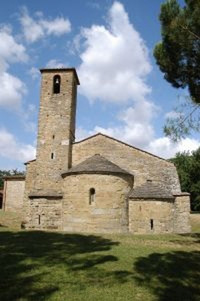
Pieve al Bagnoro, Arezzo

Pieve di San Donnino a Maiano
|
The Palazzo dei Priori, erected in 1333, has been the seat of the city's magistratures until today. The edifice was numerous times restored and renovated; the interior has a court from the 16th century, a stone statue portraying a Madonna with Child (1339), frescoes, busts of illustrious Aretines, two paintings by Giorgio Vasari. The square tower is from 1337.
|
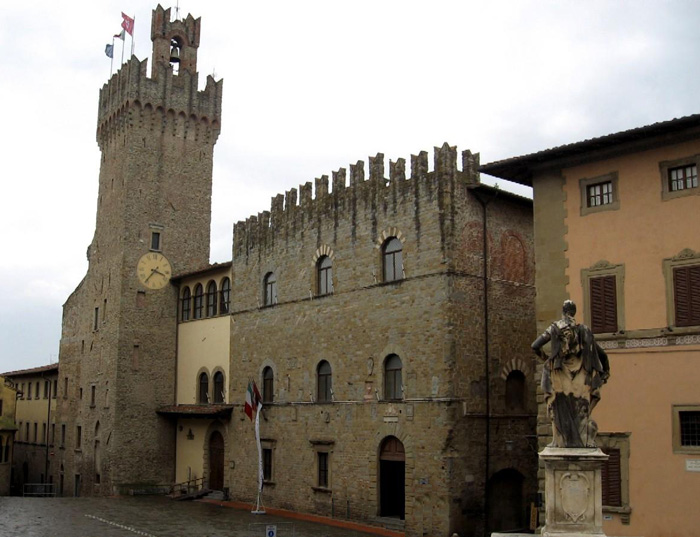 |
Palazzo dei Priori
|
Palazzo dei Priori was built in 1333, and from the late middle ages to the present day, has housed the highest magistrature of the town: it is now the seat of the organs and offices of the town council.
The via Ricasoli side bears the clearest traces of the original 14th century architecture; the facade and the characteristic tower (1337, with a clock from the following century) are the result of the numerous modifications and restorations carried out in the 15th and 16th centuries, as well as in the 17th century, following the disastrous collapse of the frontal part.
The last rebuilding, carried out by Giuseppe Castellucci and Umberto Tavanti, dates back to 1930, and made significant changes both to its external appearance (castellations on the facade, the top of the tower) and to the internal organization of its rooms.
The interior contains a cortile with portico that dates back to the 16th century. Outside the portico, above which, on the upper floors, there are two galleries, recent building has created an actractive new entrance from via Montetini below.
Inside the ground floor hall (entrance in piazza della Libertà, door to the right) there is a "Madonna with Child and S.Donato" by Salvi Castellucci (1640), with an unusual view of 17th century Arezzo as its background.
Going up to the next floor, one should note the religious frescoes, the numerous portraits and busts of illustrious citizens of Arezzo distributed through the various rooms, the stone statue of the "Madonna with Child" (1339) (transferred from the demolished porta S. Spirito), the "Sala dei Matrimoni" (Hall of Weddings), with its 16th century stone fireplace, two paintings by Giorgio Vasari and twelve scenes from Aretine history in fresco by Teofilo Torri (1610), the "Sala del Consiglio", (Council Hall) with its 15th century fresco of the "Crucifixion" by Parri di Spinello and the portrait of Pietro Aretino.
From the last floor, which has recently been restored, one gains access to the tower.
|
Roman amphitheatre and museum.
The Roman Amphitheatre in Arezzo is situated in the southern part of the ''walled city'' and can be reached from Via Margaritone and Via F.Crispi. It was built between the end of the 1st century and the beginning of the 2nd century A.D. with blocks of sandstone, bricks and marble; it is elliptic in shape and has two sets of stairs. Its longest axis measures 121 m and probably it could contain eight thousand people.
It has been repeatedly sacked in the past centuries and its most precious materials have been taken away and used as building material in religious works. It has also been partly buried, but the stalls and part of the ambulatories are still visible. The 16th century Monastery of S.Bernardo and now the site of the Archaeological Museum were built on the remains of the southern semi-circle.
Medici Fortress (Fortezza Medicea), designed by Antonio da Sangallo the Younger and completed in 1538–1560. It was partly dismantled by the French in the early 19th century.
Palazzo Camaiani-Albergotti (14th century, renovated in the 16th century), with the Torre della Bigazza.
Palazzo Bruni-Ciocchi. A renaissance building known as the palazzo della Dogana (custom-house) because of its 19th century function. It was built half way through the 15th century, following a project attributed to Bernardo Rossellino. Situated at the crossroads of via S.Lorentino and via Garibaldi, it has been owned, during the course of the centuries, by the Bruni, the Ciocchi and the Barbolani families and has been restructured on various occasions. After the Restoration, the government of Tuscany turned it into the seat of the customs and state monopolies (salt and tobacco). It was greatly restored after the last war, and now houses the Museum of Medieval and Modern Art.
Palazzo Pretorio, which was seat of the People's Captain until 1290. The façade has coat of armas of the captains, podestà and commissaries of the city from 14th to 18th century. Only one of the two original towers remains.
House of Petrarch (Casa del Petrarca).
Casa Vasari (in Via XX Settembre) an older house rebuilt in 1547 by Giorgio Vasari and frescoed by him; now open as a museum, it also contains 16th-century archives. The main rooms were decorated by Vasari in an illusionist manner. the drawing room, where Vasare painted the life journey of an artist, with the artistic virtues protected by the gods of antiquite represented as heavenly bodies, is remarkable.
Events | Giostra del Saracino
|
Giostra del Saracino is an ancient game of chivalry. It dates back to the Middle Ages. The historical reenactment takes place every year in Arezzo on the last but one Saturday of June, by night (the so-called San Donato Joust, dedicated to the patron saint of the town) and on the first Sunday of September, in the afternoon (the September Joust). The protagonists of the event are the four quarters of the town of Arezzo.
Events in Tuscany | Giostra del Saracino |
|
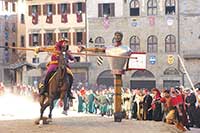
|
|
|
| |
|
Visualizzazione ingrandita della mappa |

[1] History | Etruscan remains establish that the acropolis of San Cornelio, a small hill next to that of San Donatus, was occupied and fortified in the Etruscan period. There is other significant Etruscan evidence: parts of walls, an Etruscan necropolis on Poggio del Sole (still named "Hill of the Sun"), and most famously, the two bronzes, the "Chimera of Arezzo" (5th century BC) and the "Minerva" (4th century BC) which were discovered in the 16th century and taken to Florence. Increasing trade connections with Greece also brought some elite goods to the Etruscan nobles of Arezzo: the krater painted by Euphronios ca 510 BC with a battle against Amazons (in the Museo Civico, Arezzo 1465) is unsurpassed.
Conquered by the Romans in 311 BC, Arretium became a military station on the via Cassia, the road to expansion by republican Rome into the basin of the Po. Arretium sided with Marius in the Roman Civil War, and the victorious Sulla planted a colony of his veterans in the half-demolished city, as Arretium Fidens ("Faithful Arretium"). The old Etruscan aristocracy was not extinguished: Gaius Cilnius Maecenas, whose name is eponymous with "patron of the arts", was of the noble Aretine Etruscan stock. The city continued to flourish as Arretium Vetus ("Old Arretium"), the third largest city in Italy in the Augustan period, well known in particular for its widely-exported pottery manufactures, the characteristic moulded and glazed Arretine ware, bucchero-ware of dark clay and red-painted vases (the so-called "coral" vases).
Around 26-261 AD the town council of Arezzo dedicated an inscription to its patron L. Petronius Taurus Volusianus. See that article for discussion of the possible political/military significance of Volusianus's association with the city.
In the 3rd to 4th century, Arezzo became an episcopal seat: it is one of the few cities whose succession of bishops are known by name without interruption to the present day, in part because they were the feudal lords of the city in the Middle Ages. The Roman city was demolished, partly through the Gothic War and the invasion of the Lombards, partly dismantled, as elsewhere throughout Europe, and the stones reused for fortifications by the Aretines. Only the amphitheater remained.
The commune of Arezzo threw off the control of its bishop in 1098 and was an independent city-state until 1384. Generally Ghibelline in tendency, it opposed Guelph Florence. In 1252 the city founded its university, the Studium. After the rout of the Battle of Campaldino (1289), which saw the death of Bishop Guglielmino Ubertini, the fortunes of Ghibelline Arezzo started to ebb, apart from a brief period under the Tarlati family, chief among them Guido Tarlati, who became bishop in 1312 and maintained good relations with the Ghibelline party. The Tarlati sought support in an alliance with Forlì and its overlords, the Ordelaffi, but failed: Arezzo yielded to Florentine domination in 1384; its individual history was subsumed by that of Florence and the Medicean Grand Duchy of Tuscany. During this period Piero della Francesca worked in the church of San Francesco di Arezzo producing the splendid frescoes, recently restored, which are Arezzo's most famous works. Afterwards the city began an economical and cultural decay, which fortunately ensured that its medieval centre was preserved.
In the 18th century the neighbouring marshes of the Val di Chiana, south of Arezzo, were drained and the region became less malarial. At the end of the century French troops led by Napoleon Bonaparte conquered Arezzo, but the city soon turned into a resistance base against the invaders with the "Viva Maria" movement, winning the city the role of provincial capital. In 1860 Arezzo became part of the Kingdom of Italy. City buildings suffered heavy damage during World War II.
[2] Pamela Zanieri., A guide to the places of Piero della Francesca, Scala, 2007
[3] Marco Bussagli, Piero Della Francesca, p. 24, Giunti Editore, 2007
[4] D. Medina Lasansky, The Renaissance perfected: architecture, spectacle, and tourism in Fascist Italy, (Buildings, Landscapes, and Societies), Pennsylvania State Univ Pr (November 1, 2005)
Mussolini's bold claims upon the monuments and rhetoric of ancient Rome have been the subject of a number of recent books. D. Medina Lasansky shows us a much less familiar side of the cultural politics of Italian Fascism, tracing its wide-ranging efforts to adapt the nation's medieval and Renaissance heritage to satisfy the regime's programs of national regeneration. Anyone acquainted with the beauties of Tuscany will be surprised to learn that architects, planners, and administrators working within Fascist programs fabricated much of what today's tourists admire as authentic. Public squares, town halls, palaces, gardens, and civic rituals (or the ‘invented traditions’ in cities like, Arezzo or San Gimignano, including the famed palio of Siena) were all 'restored' to suit a vision of the past shaped by Fascist notions of virile power, social order, and national achievement in the arts. Ultimately, Lasansky forces readers to question long-standing assumptions about the Renaissance even as she expands the parameters of what constitutes Fascist culture.The arguments in The Renaissance Perfected are based in fresh archival evidence and a rich collection of illustrations, many reproduced for the first time, ranging from photographs and architectural drawings to tourist posters and film stills.
References
Montenegro, Riccardo (May 2007). "Un'arte per tutte le stagioni". Medioevo (124): pp. 34–35.
Roberto Manescalchi, Appunti concernenti la fortuna storica del polittico della Madonna della Misericordia di Piero della Francesca. Heliopolis (in collaborazione con Sergio Pittino)1980
Madonna della Misericordia (Piero della Francesca)
|
|
|
#travelingintuscany Arezzo, Piazza Grande, Palazzo dei Tribunale and Santa Maria della Pieve, view of the apse.
The two rows of loggia recall the façade's structure, repeating the use of different style capitals.
|

Piero della Francesca e le corti italiane | Piero della Francesca and the Italian Courts
Museo Statale d’Arte Medievale e Moderna
Arezzo, Via S. Lorentino 8 | www.mostrapierodellafrancesca.it
31st March – 22nd July 2007 | Press releases
Exhibition Itinerary
Art in Tuscany | Giorgio Vasari's Lives of the Artists | Piero della Francesca
Art in Tuscany | Madonna della Misericordia | Madonna of Mercy
Guido Botticelli | Il restauro del San Lodovico di Piero della Francesca | L'intervento conservativo sul S.Lodovico di Piero della Francesca
Piero della Francesca | La Leggenda della Vera Croce
Comune Arezzo | www.comune.arezzo.it
Film in Tuscany | Arezzo, Sansepolcro and Monterchi, the homeland of Piero della Francesca
In the footsteps of Piero della Francesca | Piero della Francesca, an itinerary in Tuscany and central Italy
Like many regions in Italy, there are several good outdoor markets and flea markets to be found in Tuscany.
Most small towns in Tuscany have a weekly market where you can buy food and household products. There is a market held every day of the week somewhere, and many of the people travel from town to town displaying their wares or selling their home-grown vegetables and fruits, or combine their Tuscan holiday with visits to one of the region's many antique markets.
Every month the town of Arezzo holds a flea market in the Piazza Grande, which is known to be one of the best in Italy.
Tuscany | Market days in Tuscany | Weekly market days in Tuscany
Here is a partial calendar of outdoor markets held in Tuscany.
Tuscany Markets are usually held in the morning between 6am and about 1:30pm.
The Antiques Market in Arezzo is a must for art lovers, collectors and connoisseurs. The fair is traditionally held on the first Sunday of every month. The monthly Antiques Market takes advantage of the extraordinary scenery of Piazza San Francesco, Piazza Grande and the Logge del Vasari, but the stalls spread over the side alleys and squares across the historic centre, transforming the character of the city for the two days of the Antique Market.
Where: The historical town centre of Arezzo: Piazza San Francesco, Piazza grande, Corso Italia and the surrounding alleys.
When: The first Sunday of every month and the Saturday before.
|
\ |

Hidden secret in southern Tuscany | Podere Santa Pia
|
| |
|
|
|
|
|
Podere Santa Pia, garden |
|
Podere Santa Pia |
|
Abbadia d’Ombrone and Monastero d’Ombrone near Castelnuovo Berardenga. |
| |
|
|
|
|
|
|
|
|
|
Palazzo Medici Riccardi, Florence |
|
Colle di Val d'Elsa |
|
Florence, Duomo
|
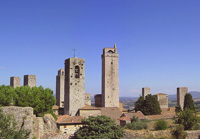 |
|
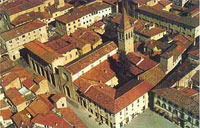
|
|
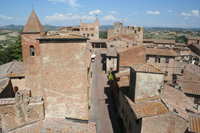 |
San Gimignano
|
|
Sansepolcro |
|
Certaldo |
| Anghiari |
|
|
|
|
Anghiari is one of the most beautiful villages in Italy. On 29 June 1440, the plain in front of Anghiari was the scene of a famous battle, which went down in history as the Battle of Anghiari, between the Florentine allies of the Holy See on the one hand, and the Milanese on the other Few people were killed, but the victory in Tuscany resulted in the reduction of territorial ambitions in Lombardy. Leonardo da Vinci, at the request of the Florentine government, immortalized this event, painting this historic battle in the Palazzo Vecchio in Florence. Unfortunately, only a few copies remain today, including a Rubens, now preserved at the Louvre Museum in Paris. Anghiari, in addition to the beautiful churches, also has important museums: The Palazzo della Battaglia, or the Museum of Memory and the Landscape in the Land of Anghiari, and the State Museum of Palazzo Taglieschi. The Museum of the Battle of Anghiari, offers the opportunity to learn about the history of the battle and the artistic heritage of Leonardo to this place. The Taglieschi Museum, houses important artistic works of great historical value, frescoes from churches and palaces of the region, a wooden polychrome Madonna by Jacopo della Quercia, and Robbia pottery.
|
|
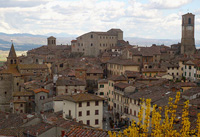
Anghiari |
| Le Opere di Piero della Francesca | Itinerario Sansepolcro Monterchi Arezzo
The painting of Piero della Francesca (1416 ca. – 1492) stands out as a noble effigy amongst the prestigious artistic testimonials guarded within the towns of the valley,. An artist who has left in his native Borgo Sansepolcro and the neighbouring Monterchi indelible evidence of his fervid work. The vast and prosperous plain of the river Tiber, crowned by mountains and gentle sloping hills and washed by the silver waters of the Tiber river are depicted in the landscapes he painted which form an important part of the legacy of 14th century Italian painting. The history of this artistic genius who up to the 19th century was more famous as a scientist, master of prospective and author of De Prospectiva Pingendi, starts in this region which had sheltered artists of various origins and cultures so that a vivacious climate of experiences, ideas and directions was generated which is reflected in a good part of the works which can still be seen in the area.
During the years when anonymous and unknown painters accepted important commissions in the valley, Piero della Francesca was signing the contract for the painting of the polyptych of the Misericordia (1445), a work destined for the church of the same name and which was transferred in 1901 to the local museum. The artist who had already assumed his humanistic traits after his Florentine experience of 1439 with Domenico Veneziano, fully developed the illumination possibilities of a gold background, transforming it into reflecting surfaces in which space is organised using the curves of the Virgin's cloak.
A sort of architecturally conceived niche therefore where the cylindrical figure of the Madonna of the Misericordia imposes herself in a perfectly axial position. On the right you can see Saint John the Baptist and Saint Sebastian while on the left are the paintings of Saint Andrew and Saint Bernardino of Siena. The upper panels depict Saint Benedict, Archangel Gabriel, the Annunciation of the Virgin and Saint Francis of Assisi whereas the painting finishes at the top with the crucifixion. In the side scenes, amongst the succession of the saints, the pilgrims Egidio and Arcano, the mythical founders of the city, are represented.
Piero della Francesca's repertory is authoritatively represented in the Civic Museum of Sansepolcro by the noble Resurrection, the very symbol of the city , by the Saint Julian originating from the deconsecrated church of saint Claire and by the saint Ludwig of Toulouse, a fragment of a fresco which was originally painted in the city's Palazzo Pretorio.
The Madonna del Parto ( the Madonna with child), was presumably painted before 1465 in seven working days. This can be verified by reading the information which the 'a fresco' technique, used by Piero gives us. The image of the Virgin is touching and human, characterised by the freshness of a girl just out of her teens. For many years the fresco formed the back wall of the ancient church of Santa Maria Momentana until in 1785, an earthquake destroyed it leaving only the wall of the fresco miraculously in tact. The work of art was successfully detached and housed in a church near Monterchi's graveyard from where it was removed in 1910 for restoration, and by complete chance it narrowly missed the 1917 earthquake which severely damaged its second home. Today it can be admired in the museum of the Madona del Parto in Monterchi.
The artistic splendour of the valley in the 15th century can also be admired by worthy painters such as Pietro di Antonio Dei (1448-1502), better known as Bartolomeo della Gatta, Luca Signorelli (1445-1523) and Pietro Perugino who have all left the imprint of their genius.
The exhibition extends and becomes an itinerary throughout the territory, allowing visitors to discover Piero's works in the Bacci Chapel in the Church of San Francesco in Arezzo, in the Dome of Arezzo, in the Museum Madonna del Parto in Monterchi and in the Civic Museum in Sansepolcro.
Sansepolcro
* The Polyptych of the Misericordia, tempera on panel, was commissioned from Piero by the Sansepolcro Compagnia of the same name in 1445. The central panel of the painting shows the Madonna of Mercy, or Misericordia, sheltering the community of the commissioners and the faithful beneath her mantle, as in a large tabernacle, with men on the left and women on the right.
* The Resurrection is a large fresco painted by Piero della Francesca on the central wall of the Council Chamber. This work, considered to be among the most representative of the artist, is the human and spiritual expression of the rebirth of Christ. Strong and solemn, the figure of the Saviour dominates the scene. In the background the artist has chosen to represent the dawn, the beginning of a new day, raised to a symbol of the dawn of life.
* The fresco portraying St. Julian was discovered in 1954 in the old church of Sant'Agostino, later dedicated to Santa Chiara. The saint, portrayed with a youthful appearance, is wrapped in an elegant red cloak which stands out against the background of antique green imitation marble.
* The detached fresco showing St. Louis, originating from the Palazzo Pretorio, shows the saint dressed in a Franciscan habit with a richly decorated bishop's cope; in the background is a fake niche of precious red and green marble.
Monterchi
* Madonna del Parto [the Pregnant Virgin Mary], Museum Madonna del Parto
The medieval hamlet stands in a location that was considered sacred by the Romans, and where the cult of Hercules used to be worshipped.
Visitors interested in Piero della Francesca’s art cannot but stop in this small town, placed between two small valleys (Val Padonchia and Val Cerfone), surrounded by holm-oak-covered hills. Piero della Francesca’s mother was born here, as witnessed by the small museum dedicated to her figure (right in the centre of the town), which also contains the famous fresco Madonna del Parto, an extraordinary portrait of the pregnant Virgin Mary.
Museo Madonna del Parto | Madonna del Parto
Painted in just seven days, the fresco represents one of the highest examples of Piero’s art.
Madonna del Parto is a masterpiece of figurative and chromatic synthesis, of equilibrium, formal essentialism, measure and extreme emotional depth. It is the image of a profound dignity, in which the Virgin’s body is moulded by solid geometries.
Arezzo
* Legend of the True Cross, Bacci Chapel, Basilica of San Francesco
* Santa Maria Maddalena, Dome
Dome | Santa Maria Maddalena
Solidly painted through a polished and pure colour geometry, the Magdalene, marked by traditional iconographic elements, effuses a serious and solemn sense of sacredness.
Itinerario
Visitors are invited to discover Piero della Francesca’s works in the province of Arezzo, by following an itinerary going through Valtiberina, Sansepolcro, Monterchi - the native hamlet of Piero’s mother Monna Romana - and Arezzo.
The Upper Valley of the Tevere river, or Valtiberina, is on the far east of Tuscany, and takes its name after the river that runs across it up to the border with Umbria. In the past, Valtiberina represented both the border and meeting point between different civilizations, the Umbri and the Etruscans, the Bizantines and the Longobardi. Piero della Francesca, in Borgo San Sepocro itself, was able to perceive the secrets of space and light, reflecting them into his works.
The Civic Museum of Sansepolcro, the artist’s native town, holds four works, the Polyptych of Mercy, the Resurrection, San Giuliano and San Ludovico.
After visiting Sansepolcro, the itinerary continues in Monterchi, in Val Cerfone. In Monterchi, which stands on the top of a hill on the border with Umbria, Piero della Francesca painted the extraordinary fresco of Madonna del Parto, in the old church of Santa Maria a Momentana.
The itinerary continues and ends in Arezzo. A splendid town standing on a hill in eastern Tuscany, just behind the Apennines between Tuscany and Romagna, Arezzo used to be one of the most important Etruscan cities and later became a strategic centre for the Romans. Here, Piero della Francesca painted one of the most important masterpieces of the Renaissance. The Bacci Chapel in the Basilica of San Francesco contains Piero della Francesca’s frescoed cycle of the Legend of the True Cross, painted for the Franciscan church between 1452 and 1466. The Dome of Arezzo displays the fresco Magdalene (at the bottom of the left nave).
Piero della Francesca in and around Arezzo | Download pdf
[Source: www.mostrapierodellafrancesca.it]
|
|
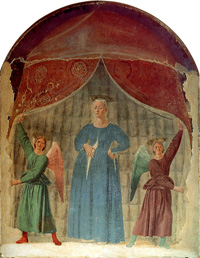
Madonna del Parto [the Pregnant Virgin Mary], Museum Madonna del Parto
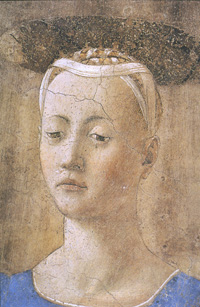 Piero della Francesca, Madonna del parto (dettaglio) Piero della Francesca, Madonna del parto (dettaglio)
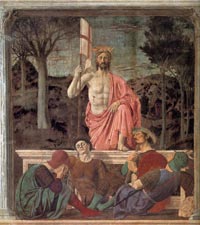
Piero della Francesca, The Resurrection, Museo Civico of Sansepolcro
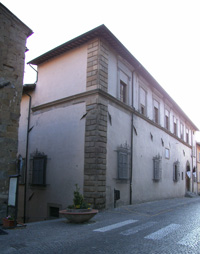
Casa di Piero della Francesca, where the artist was born.It is an elegant building that, it is said, was designed by Piero himself, with an architecture which, for the portal and windows, seems very reminiscent of Michelozzi’s style (1396-1472).
|
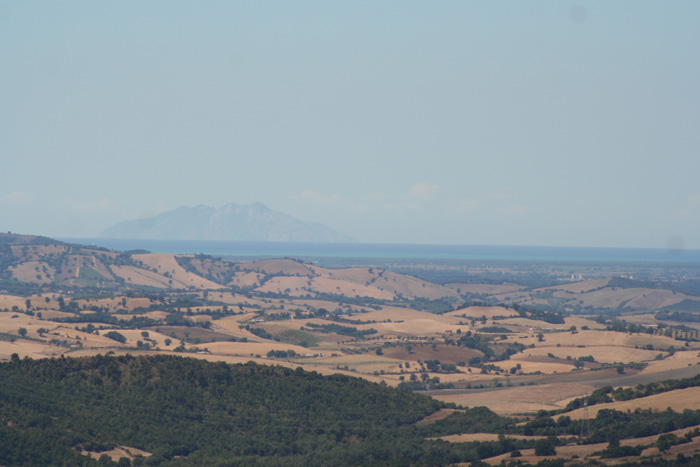 |
Podere Santa Pia, situated in a particularly scenic valley,
which overlooks on the hills around Scansano, up to the Maremma seashore and Monte Christo. |
|
|
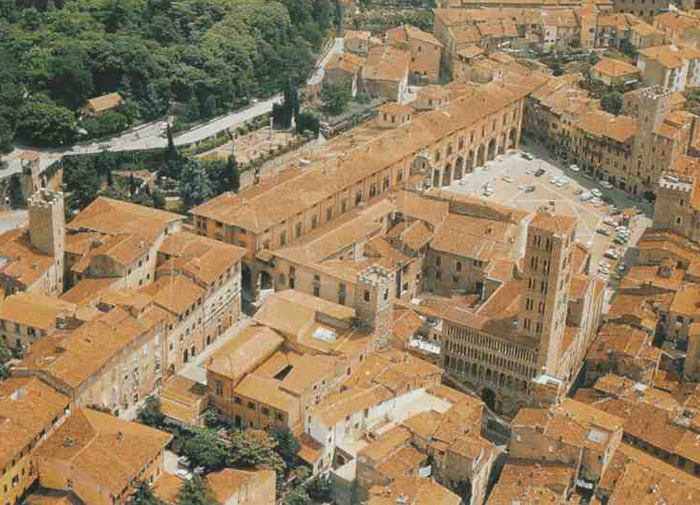















 Santa Maria Maddalena, Dome, Arezzo
Santa Maria Maddalena, Dome, Arezzo
